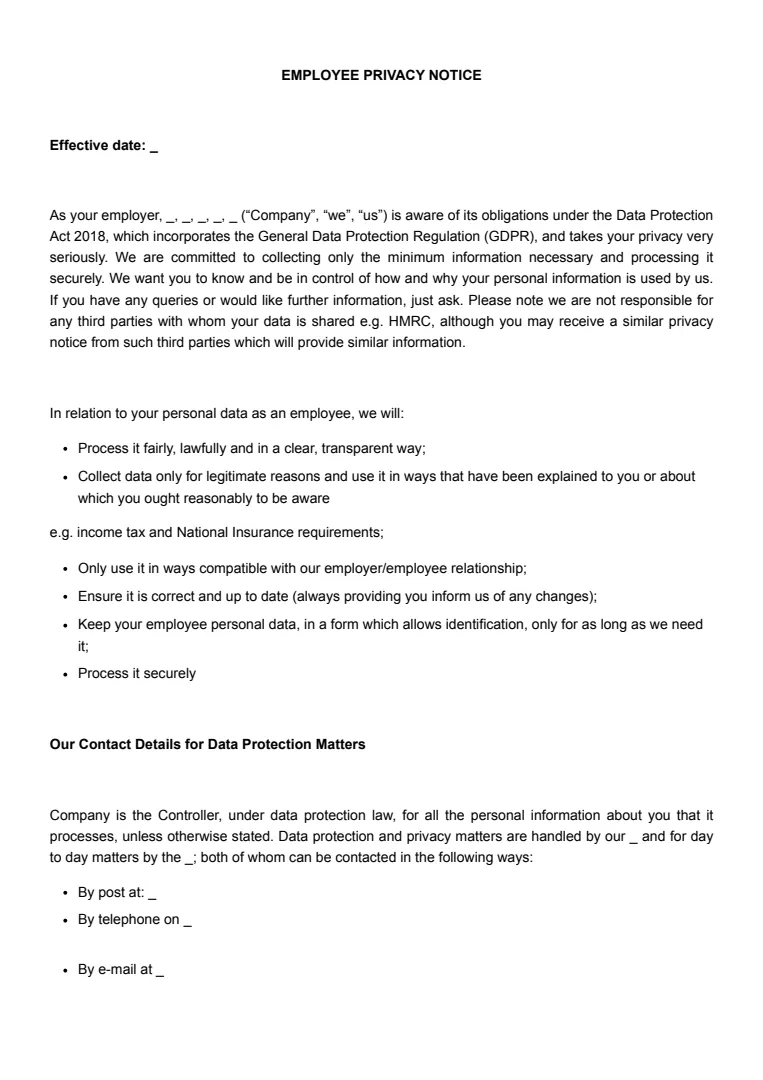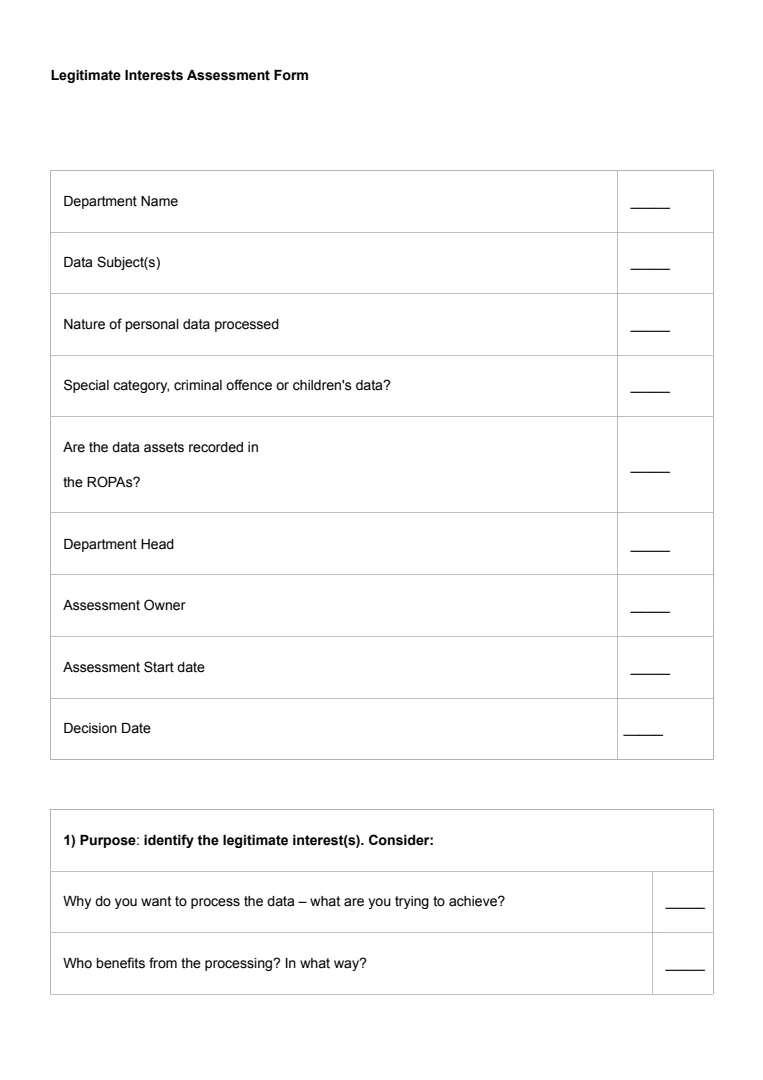What Is an Employee Privacy Notice?
An employee privacy notice is a formal document provided by your employer to explain how your personal data is collected, used, and protected.
It sets out the types of personal information your employer processes and details the reasons for using this data.
Under the General Data Protection Regulation (GDPR), organisations are required to give clear information about data privacy to employees.
A privacy notice helps you understand your rights and how your sensitive personal information is managed at work.
Common types of personal data covered include:
- Name, address, and contact details
- National Insurance number
- Payroll information
- Employment history
- Performance records
For sensitive personal data, the notice may address:
- Health information
- Racial or ethnic origin
- Trade union membership
- Criminal record checks
When Is an Employee Privacy Notice Needed?
If you’re an employer, you need to provide an employee privacy notice whenever you collect, use, or store personal data during the employment or recruitment process.
Recruitment
A privacy notice is required as soon as you collect candidate data, even if they don’t progress to employment.
This includes receiving CVs, processing applications, or gathering information during interviews.
Right to Work Checks
When verifying the right to work, you’re handling sensitive identification documents.
At this point, you must inform individuals how their data is managed and why you need it.
Employment Contracts
Employees should receive a privacy notice before or when they sign an employment contract.
This clarifies how their information will be used throughout the working relationship.
Employment Lifecycle
You must update or reissue the privacy notice if there are changes in how data is processed, such as introducing new HR systems or policies.
You’re also required to give a privacy notice to contractors, temporary workers, and agency staff if you process their data for work-related purposes.
You should ensure the privacy notice is accessible and clear at every relevant stage to comply with data protection laws and build trust. This could be through an employee privacy policy.
How to Write an Employee Privacy Notice
If you’re an employer, you’ll need to have a clear employee privacy notice in place that’s accessible to all employees. You can create one by following these steps.
Step 1: Start With the Introduction and Purpose
Begin the document by clearly stating its purpose: to inform employees about how their personal data is collected, used, stored, and protected by the employer.
This introduction sets the tone for transparency and compliance.
You should mention the organisation’s name and affirm its commitment to handling employee data in accordance with applicable data protection laws.
Clearly indicate that the document is intended for all employees, and specify the effective date of the privacy notice.
Ensure the language is straightforward, allowing employees to easily understand it, regardless of their legal knowledge.
Step 2: Define the Scope of the Notice
Next, explain who the privacy notice applies to.
Indicate whether it covers only current employees or also includes job applicants, former employees, contractors, interns, and agency workers.
You should also clarify whether this notice is specific to a region or applies globally if your organisation operates in multiple jurisdictions.
This section helps employees understand whether the notice is relevant to them and which parts may apply to their specific status.
Step 3: Identify the Types of Personal Data Collected
Now, outline the categories of personal data your company collects.
Be specific and include examples such as name, contact details, employment history, financial information, health data, and any other relevant information obtained through the employment relationship.
You should also mention whether any sensitive or special categories of data are collected, such as health records, biometric data, or criminal background information.
Explain that only data necessary for legitimate employment purposes is collected.
This section helps build trust and transparency with employees.
Step 4: Explain the Legal Basis for Processing Data
After defining what data is collected, you need to explain the legal grounds for collecting and using it.
Refer to the relevant legal frameworks (e.g., the GDPR or local data protection laws), and describe which legal bases apply, such as performance of a contract, compliance with legal obligations, legitimate interests of the employer, or consent in some cases.
Match each legal basis to the type of data or processing where applicable.
This section ensures legal accountability and helps employees understand why their data is being used.
Step 5: Describe How the Data Will Be Used
List and describe the purposes for which the company processes personal data.
This may include recruitment, payroll, benefits administration, performance evaluations, disciplinary actions, and legal compliance.
Also, explain if the data will be used for monitoring work activity, accessing company systems, or ensuring workplace safety and security.
Employees need to know not only what data is collected, but also how it will be used throughout their employment lifecycle.
Step 6: Identify Data Sharing and Third Parties
In this step, outline who the company may share employee data with.
List any third-party service providers, such as payroll processors, benefit providers, legal advisors, or IT support companies.
Specify whether data is ever transferred outside the employee’s country of employment and, if so, what safeguards are in place (e.g., data transfer agreements or standard contractual clauses).
This helps employees understand where their data may go and what protections are in place when it is shared.
Step 7: Explain Data Retention Practices
Now, explain how long the company retains different types of personal data.
Specify the retention period for various records, such as job applications, employment contracts, disciplinary records, and health data, or indicate the criteria used to determine the retention period.
You should also describe what happens to the data once it is no longer needed, such as secure deletion or anonymisation.
This section shows employees that you do not keep their personal information indefinitely and take data minimisation seriously.
Step 8: Outline Data Security Measures
Describe the technical and organisational measures the company uses to protect employee data from unauthorised access, loss, or misuse.
This can include encryption, secure servers, access controls, password policies, and staff training.
Emphasise your company’s commitment to keeping employee information safe.
This section reassures employees that their data is being handled responsibly and securely.
Step 9: Detail Employee Rights
Clearly outline the rights employees have over their personal data under applicable data protection laws.
These typically include the right to access their data, correct inaccuracies, request deletion, restrict processing, object to certain uses, and data portability.
Explain how employees can exercise these rights, such as by contacting a specific department or data protection officer, and how quickly the company will respond.
This section empowers employees to take control of their data and fosters transparency.
Step 10: Provide Contact Information for Questions or Complaints
Finally, give employees a point of contact for any questions or concerns about their data privacy.
This is usually the company’s data protection officer, HR representative, or legal department.
Include their name (if applicable), email address, phone number, and physical office location if relevant.
Also, mention the employee’s right to file a complaint with a supervisory authority if they believe their data rights have been violated.
End the document by thanking employees for their attention and reminding them that privacy is a shared responsibility.
















